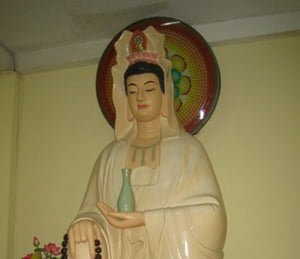
Though these days people in the West view him as a figure of bizarre fascination and even horror, Thich Quang Duc remains a hero to Vietnamese Buddhists, and is even called Thich Quang Duc Bo Tat - the Bodhisattva Thich Quang Duc.

He is the monk famous for burning himself alive in protest at the continued Vietnam-American war, and the image of his burning body sitting upright in the lotus position became a worldwide symbol of the anti-war protest movement.
Though he hailed from Hue, Thich Quang Duc was normally resident at Saigon, at the Quan Am Pagoda in Phu Nhuan District.

This temple is still there, on the re-named Thich Quang Duc street, and upstairs it has a small and rarely visited museum to the Bodhisattva. Normally closed to visitors, it contains various relics of Thich Quang Duc - his pillows, his clothes, his books and other everyday items. The temple also has his most sacred relic, the small charred heart that was left after his body had been consumed by petrol-fuelled flames. This heart will be housed in a large tower being constructed at the top of the temple. It may well be finished by now (I'd love to hear from anyone in Saigon who is aware of its progress), and it is already a striking landmark in that part of the district. At the very top of the tower is a large sculpture of two hands clasped together in prayer. It is really quite beautiful.
Though Thich Quang Duc was the first of the Buddhist martyrs, many were to follow, both monastic and lay people.

For many years a small monmument to Thich Quang Duc stood at the corner of Nguyen Dinh Chieu Street and Cach Mang Thang Tam Street in Saigon, but recently a brand new one has been opened by the City authorities just across the road, as part of a memorial park.



No comments:
Post a Comment